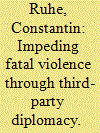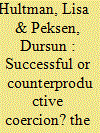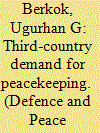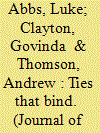|
|
|
Sort Order |
|
|
|
Items / Page
|
|
|
|
|
|
|
| Srl | Item |
| 1 |
ID:
180193


|
|
|
|
|
| Summary/Abstract |
Existing research provides no systematic insights into if and how mediation impedes battle-related deaths. Therefore, this article presents a temporally disaggregated analysis and assesses the effect of mediation on monthly fatal violence. The article predicts that adversaries evaluate opponents’ trustworthiness from both fighting and negotiation behavior. It argues that reducing fighting intensity during negotiations is a sign of cooperation, which can be negotiated by mediators to build trust. Over the course of mediation, the content of negotiations provides information about how genuinely a conflict party is interested in conflict resolution. Only if mediation achieves negotiation of core incompatibilities will conflict parties be willing to reduce fighting intensity. Under these conditions, information revealed in a mediation process can build trust and substantively reduce violence. An empirical analysis of all African conflicts between 1993 and 2007 supports this prediction and shows that on average mediation is followed by substantive and lasting reductions in fatal violence, if mediation discusses the conflict’s main incompatibility. In contrast, mediation on other topics is associated with a small, fleeting reduction in violence. Data of battle-related fatalities in Syria during negotiations as well as qualitative evidence further support the theoretical mechanism and the model prediction. The study concludes that mediation can reduce conflict intensity substantively, if it achieves exchange between conflict parties on the main conflict issues.
|
|
|
|
|
|
|
|
|
|
|
|
|
|
|
|
| 2 |
ID:
174726


|
|
|
|
|
| Summary/Abstract |
Although often conjectured, there is a lack of empirical evidence whether international inflows of military technology render intrastate conflicts more violent. We address this question and argue that expansions in governments’ ability to fight aggravate the lethality of intrastate war. However, we expect this effect to be conditioned by rebels’ military endowments and their choice of tactics. Where rebels are weak, they avoid open combat, and additional governmental arms imports have no effect on the number of casualties. In contrast, governmental arms imports cause human losses to multiply when rebels have achieved military parity or superiority and, as a consequence, use conventional combat tactics. This hypothesis is tested on the number of battle-related deaths in intrastate conflict, 1989 to 2011, using, for the first time, data on governmental imports of both major conventional weapons and small arms. Results support our propositions and are robust to instrumenting for imports of both types of weapons.
|
|
|
|
|
|
|
|
|
|
|
|
|
|
|
|
| 3 |
ID:
140864


|
|
|
|
|
| Summary/Abstract |
Why do some of Afghanistan's provinces experience more deadly attacks on counterinsurgents than others? We argue that provinces with more militarily effective insurgents will be deadlier for the forces of the counterinsurgency. We posit that insurgent military effectiveness is an interactive function of the rebel group's size, the quality of its recruits, and the group's operational budget. More militarily effective insurgents should, in turn, produce more deadly violence against Coalition forces. We model this relationship at the provincial level in Afghanistan using negative binomial regressions. Ultimately, we find that in provinces where the insurgency is more militarily effective, deadly attacks against counterinsurgent forces occur more often. Based on this finding, we conclude with directions for future research and policy recommendations for both the current operations in Afghanistan and for future counterinsurgency campaigns.
|
|
|
|
|
|
|
|
|
|
|
|
|
|
|
|
| 4 |
ID:
153662


|
|
|
|
|
| Summary/Abstract |
Despite the frequent use of economic and military-specific sanctions against countries affected by civil conflicts, little is known about the possible impact that these coercive tools have on conflict dynamics. This article examines how threats and imposition of international sanctions affect the intensity of civil conflict violence. We formulate and test two competing views on the possible effect of economic and military-specific sanctions on conflict dynamics by combining data on fatalities in battle-related violence in all internal armed conflicts in Africa from 1989 to 2005 with data on economic sanctions and arms embargoes. The results indicate that threats of economic sanction and arms embargo are likely to increase the intensity of conflict violence. Similarly, imposed economic sanctions are likely to contribute to the escalation of conflict violence. Imposed arms embargoes, on the other hand, are likely to reduce conflict violence. We conclude that international sanctions appear to be counterproductive policy tools in mitigating the human cost of civil conflicts unless they are in the form of imposed arms embargoes attempting to limit the military capacity of the warring parties.
|
|
|
|
|
|
|
|
|
|
|
|
|
|
|
|
| 5 |
ID:
073785


|
|
|
|
|
| Publication |
2006.
|
| Summary/Abstract |
A third country's peacekeeping demand typically arises because of a conflict spilling over the national boundary, economically and politically as well as spatially, from the country in conflict. Economic and geographic proximities, as well as the intensity of the original conflict, increase the demand for peacekeeping by third countries. Moreover, strategic considerations such as free?riding may significantly alter the level of overall demand for peacekeeping. Discreteness in military technology and leadership by signalling may alleviate the collective action problem and increase peacekeeping contributions towards the optimum from their simple Nash equilibrium levels.
|
|
|
|
|
|
|
|
|
|
|
|
|
|
|
|
| 6 |
ID:
172330


|
|
|
|
|
| Summary/Abstract |
Existing research reveals many of the ways pro-government militia (PGM) shape civil violence but overlooks how the ethno-political ties between the state and a PGM might influence these effects. We argue that co-ethnic militia (i.e., groups composed of the ruling elite’s ethnic kin) are relatively loyal irregular forces that multiply state military capacity. The greater loyalty of co-ethnic groups mitigates principal–agent problems but further polarizes ethnic communities, and as a result, co-ethnic PGMs are likely to be associated with longer and more intense civil conflict. We test this argument on a global sample of cases from 1989 to 2007 using new data capturing the ethnic ties of all PGMs. The results support our claims that co-ethnic militia are associated with more intense and longer civil conflict.
|
|
|
|
|
|
|
|
|
|
|
|
|
|
|
|
| 7 |
ID:
133704


|
|
|
|
|
| Publication |
2014.
|
| Summary/Abstract |
We design an experiment to explore the impact of earned entitlements on the frequency and intensity of conflicts in a two-stage conflict game where players may attempt to use non-binding side-payments to avoid conflict. In this game, Proposers make offers and Responders decide simultaneously whether to accept the offers and whether to engage in a conflict. A simple theoretical analysis suggests that Proposers should never offer side-payments because Responders should always accept them and then still choose to enter conflict; however, our experiment reveals that some individuals use this non-binding mechanism to avoid conflict. Moreover, when subjects earn their roles (Proposer or Responder), conflicts are 44% more likely to be avoided than when roles are assigned randomly. Earned entitlements impact behavior in three important ways: (1) Proposers who have earned their position persistently make larger offers; (2) larger offers lead to a lower probability of conflict; but (3) Proposers whose offers do not lead to conflict resolution respond spitefully with greater conflict expenditure. Hence, with earned rights, the positive welfare effects of reduced conflict frequency are offset by higher conflict intensity. This result differs from previous experimental evidence from ultimatum games in which earned entitlements tend to encourage agreement and increase welfare; thus, our findings highlight the important consequences of endogenizing the costs of conflict. Our analysis suggests that earned entitlements alter behavior by influencing the beliefs of Proposers about the willingness of Responders to accept a peaceful resolution. As a result, these Proposers make persistent high offers, and when their beliefs are disappointed by a Responder's decision to accept a side-payment and still enter conflict, they retaliate.
|
|
|
|
|
|
|
|
|
|
|
|
|
|
|
|
|
|
|
|
|